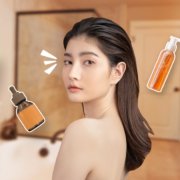How to Determine Your Skin Type
Your skin type is typically determined by a combination of your genetics, the climate, changes in your hormones, medications, diet, allergies or skin care. Because of all these different factors, your skin can vary season to season or depending on what time of foods you are eating.
However, when it comes to the health and care of your skin, it is important for you to nail down your skin type. Once you have that foundation, you can begin to seek out skincare products and adopt healthy habits that are ideal for someone with your skin type.
Typically, your skin will fall into one of four categories: dry, oily, normal/combination or sensitive. Below, we’ll break down the different skin types and show you how to determine which category your skin falls into.
Dry
Dry skin is defined as skin that is tight, flaky and lacking in moisture. Characteristics of dry skin can include almost invisible pores, dull, rough complexion, red patches, less elasticity in the skin, more visible lines. Your skin may also become rough and scaly, especially on the backs of your hands, arms and legs.
The key to treating dry skin is moisturizing. If you have dry skin, lotions and rich cream will be your best friends. Apply moisturizer several times each day, avoid harsh soaps or products that contain citrus oils and lots of fragrances. Look for water-based projects as oil-based products can make your dry skin worse. And, as always, drink lots of water.
Oily
Oily skin is defined as skin that is shiny and prone to breakouts and acne. Characteristics of oily skin can include enlarged pores, dull or shiny, thick complexion, blackheads, pimples or blemishes.
If you have oily skin, make sure to clean your face at least twice a day with liquid and gel cleansers. Stay away from products that have heavy creams. Instead, seek out products that are oil-free so you don’t inadvertently add more oil to your skin. Chemical exfoliants and clay masks will also help bring balance back to your skin.
Combination
Combination skin is defined as skin that exhibits multiple skin types at once. For example, you could have skin that includes both oily and dry skin characteristics. Typically, combination skin is identified by a consistently oily T-zone (the area of your forehead right above your eyebrows and along the top of your nose) with dryness in other areas of the face.
Combination skin is the most common skin type. If your skin falls into this category, you are going to want to use different products for different areas of your face in order to keep your skin well-balanced. Look for mild, gel cleansers and alcohol-free toners on oily areas and hydrate dry areas with light serums and moisturizers.
Sensitive
Sensitive skin is defined as skin that is easily aggravated by harsh products or weather, resulting in rashes, stinging and/or blotchy patches. If you have sensitive skin, it is important for you to try to find out what your triggers are so that you can avoid them.
As one of the most delicate skin types to handle, there are some helpful precautions to take when seeking out an idea skincare routine. Avoid products that contain harsh ingredients and don’t use products with too many active ingredients at one time.
Which skin type are you?
Now that you know a bit more about the different skin types, it is time to see which category you belong in.
- First, wash your face and be sure to remove any products, lotions or makeup.
- Pat your face dry with a towel and leave it alone.
- Avoid touching your face or putting on any type of products for at least one hour.
- Once the hour is over, examine your face in the mirror.
If your skin appears to be tight and flakey or it feels itchy, there’s a good chance you fall into the dry skin category. If your skin appears to be shiny and greasy all over, you are probably an oily skin type. If you notice oil in your T-zone but appear to be dry on your cheeks or jawline, you are more than likely a combination skin type. If you see that your skin is red, irritated or inflamed there is a very good chance that you have sensitive skin.
Still not sure what skin type you are? The best way to determine your skin type is to schedule a visit with our dermatologists. They will be able to help you identify your skin type and recommend products that are best for you.
Call our Patient Care Lines: (+632) 7-368 5238 l (+63) 917 862 7454 l (+63) 921 217 0517 for inquiries, questions, and appointments or talk to our consultants via LiveChat at https://shinagawa.ph so we can address and answer them for you.






